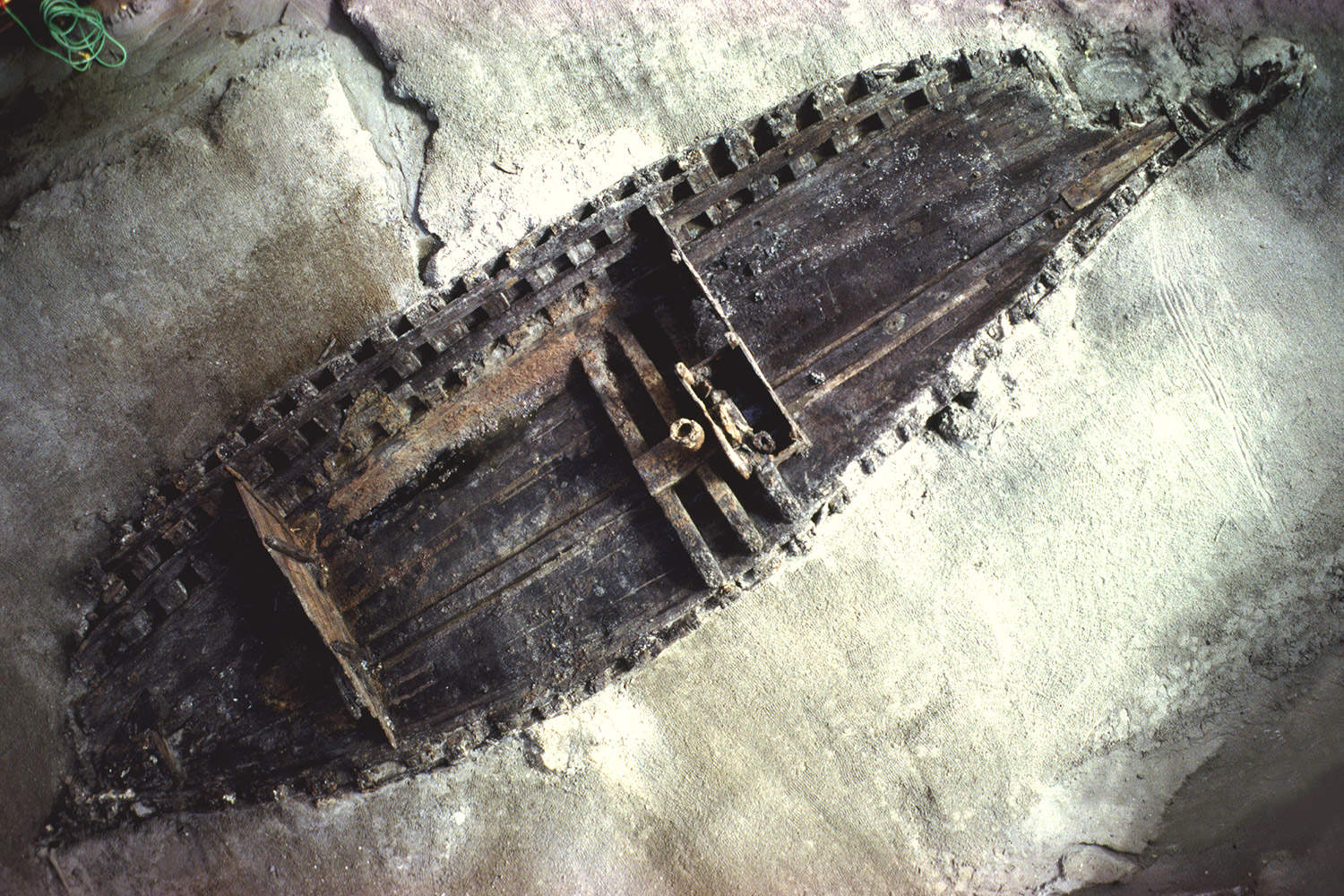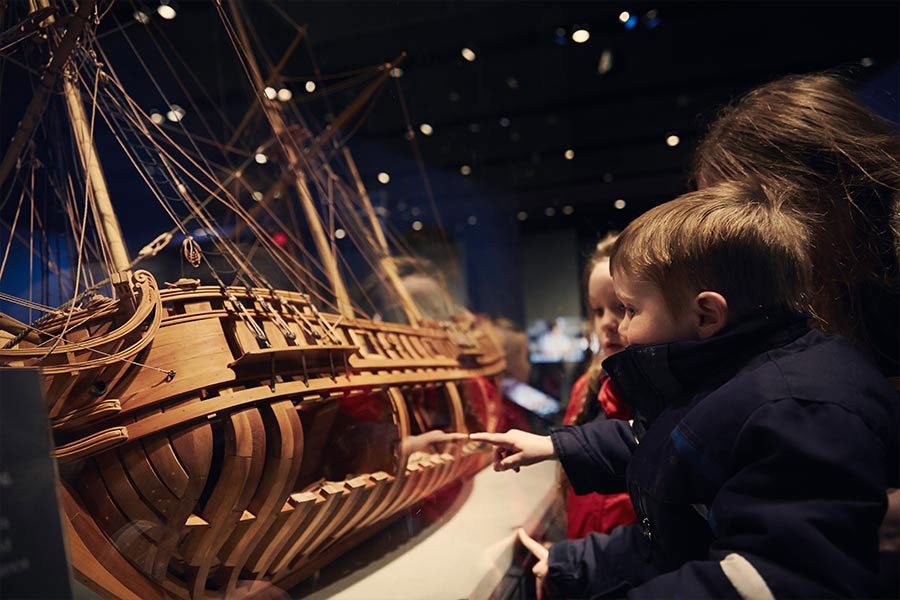Bullock Museum to close a portion of permanent exhibit space for renovation
Historic ship to be at center of new interpretations of early Texas history
FEBRUARY 13, 2014 (AUSTIN, TX) — A portion of the Bullock Texas State History Museum's first floor of permanent exhibitions will close Feb. 17, 2015, to prepare for a major renovation centered on one of the most significant artifacts in Texas history. About 11,000 of the museum's 34,000 square feet of public exhibition space will undergo a complete transformation over the next year, with reopening slated for 2016.
The $10-million project to renovate this floor of the museum's Texas History Galleries chronicling more than 14,000 years of Texas human history to 1821, is under way, and the closure sets in motion various phases of exhibition de-installations, major construction and new artifact installations that will occur over the next 12 to 15 months.
The impetus for the reinterpretation is to permanently install at the center of the first floor gallery one of the most remarkable artifacts in Texas history— the remains of the French ship, "La Belle."
"It is rare for a state history museum, or any museum, to have such a comprehensive collection of artifacts from the 1680s," Bullock Museum Director Dr. Victoria Ramirez said. "'La Belle' and its cargo will combine with other original artifacts, documents, and interactive video to tell the story of early Texas."
In what is one of the most unique public displays in the world, the 300-year old ship currently is being reassembled by experts in the museum's Herzstein Hall as a "live-action" exhibition, "La Belle: The Ship That Changed History."
This 6,000-sq. ft. exhibition presents the journey of those aboard one of French explorer René-Robert Cavelier, Sieur de La Salle's 17th-century ships bound for the Mississippi River that instead landed on the Texas coast. "La Belle," which sank during a storm in Matagorda Bay 1686, changed the course of Texas history when failed French colonization efforts spurred the Spanish to gain a greater foothold in what would become Texas.
"One of the most important shipwrecks in North America has turned out to be one of the most unique exhibitions in the world," Ramirez said. "Usually these types of rebuilds are completed behind closed doors. We have invited our members and the public to watch the ship's rebuild in preparation for its permanent installation in our first-floor gallery."
The temporary "La Belle" exhibition now on view will remain open through May 17, 2015, when the rebuilding of the bottom third of the hull is scheduled for completion. The hull then will be moved to its permanent location. Construction will continue around the ship and visitors will be able to follow the progress of the renovation with views afforded from the museum's second- and third-floor galleries.
"Those who are interested in following the renovation of the first floor, can sign up for the museum's email newsletter or follow the Bullock Museum on Facebook and Twitter," Ramirez said. "By becoming a member, Texans can be part of the changing history of the museum and can come back time after time to follow the construction. Members also will receive special invitations to see the space before it opens to the public."
An interim "La Belle" exhibition featuring the hull and select artifacts will reopen on Aug. 8, 2015 and construction will continue, with the entire first floor reopening in 2016.
In 2016, the excavated hull timbers of the ship will be preserved underneath a walkable deck of glass, with new masts built to soar three stories above visitors. Original artifacts, ranging from tiny beads and personal belongings to cannons and muskets, will be on view, adding real-life substance to the stories of the people affected by events that changed history.
In conjunction with the La Belle project, the Bullock Museum also has produced a $1-million immersive film entitled, "Shipwrecked," new educational programming, a web microsite, and accompanying book detailing the 17th-century expedition and modern conservation efforts, currently available in the Museum Store.
Ralph Appelbaum Associates (RAA), the world's largest museum exhibition design firm, was chosen to develop the new design. With offices in New York City, London and Beijing, the prestigious firm has completed work for such institutions as the Royal Albert Memorial Hall, the National Museum of Scotland, United States Capitol Visitors Center, the National Constitution Center, and many others.
According to RAA Associate Christopher Miceli, the Bullock Museum's vision provides a new concept for the entire permanent exhibition.
"With Texas as inspiration – its spectacular landscapes, its history, ripe with drama, conflict, tragedy and triumph – the new vision for the Museum aims to position the Bullock Museum as a national leader in the history museum field, and to provide the broadest possible audience with an unequalled museum experience," Miceli said.
When completed, the exhibitions will offer a new and comprehensive look at the many dynamic and complex encounters between regional American Indians, the French, and the Spanish that greatly influenced the course of global history and laid the foundation for Texas's own unique story. For more information and updates, visit TheStoryofTexas.com and follow the Bullock Museum on Twitter and Facebook.
Downloads
The Bullock Texas State History Museum, a division of the State Preservation Board and an accredited institution of the American Alliance of Museums, creates experiences that educate, engage, and encourage a deeper understanding of Texas. With dynamic, award-winning exhibitions that illuminate Texas history, people, and culture, educational programming for all ages, and an IMAX® theater with a screen the size of Texas, the Museum collaborates with more than 700 museums, libraries, archives, organizations, and individuals across the world to bring the Story of Texas to life. For more information, visit www.TheStoryofTexas.com
Media Contact
| General Inquiries | |
|---|---|
| 512-463-5424 | |

